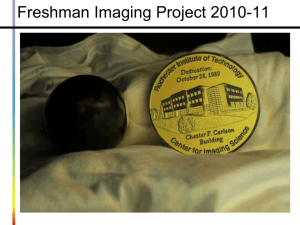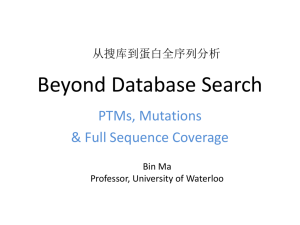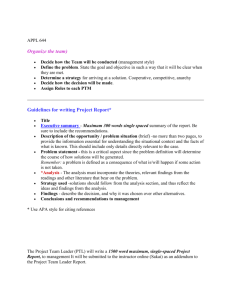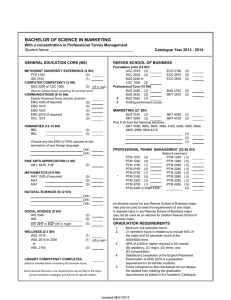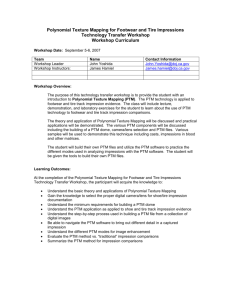Polynomial Texture Maps Tom Malzbender Dan Gelb
advertisement
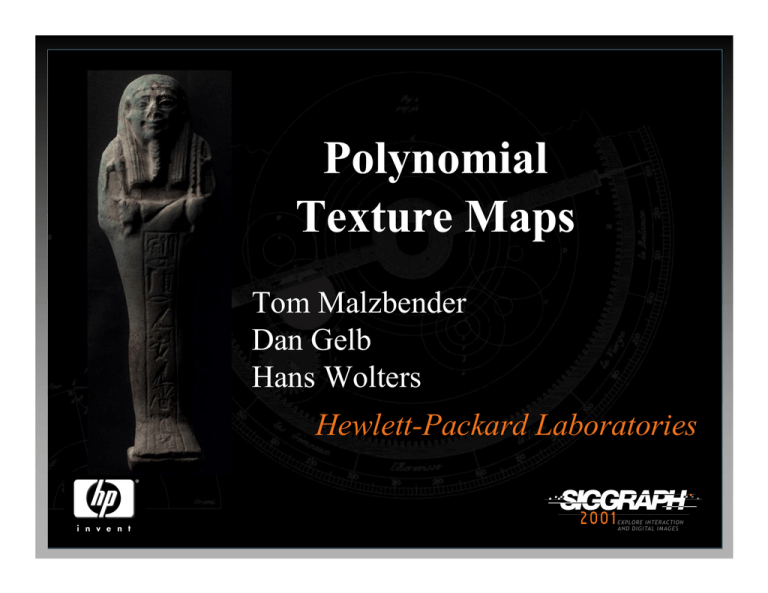
Polynomial Texture Maps Tom Malzbender Dan Gelb Hans Wolters Hewlett-Packard Laboratories Texture Mapping [ Catmull ‘74 ] Pro: • Photographic input • Simplicity • Hardware Support Con: • Unrealistic Silhouettes • Static Lighting Bump Mapping [ Blinn 78 ] Pro: • Lighting Variations Con: • Per-pixel lighting computation • Filtering is Problematic • Procedural Synthesis (Not image-based.) [ Rushmeier ‘97 ] PTM Demonstration: Top: Polynomial Texture Map Bottom: Conventional Texture Map Advantages: • Image based unlike Bump Mapping • Simpler to evaluate than Bump Mapping • Can leverage Mip Mapping Acquiring PTM’s Photographically • Fixed object, fixed camera. • Limited to Diffuse Objects. Acquiring Lighting Models Debevec Goerghiades ‘99 Modeling Pixel Color Changes Directly (u,v) Light Direction Space 2 2 L(u,v;lu ,lv ) = a0 lu + a1lv + a 2lu lv + a3lu + a4 lv + a5 Modeling Pixel Color Changes Directly (u,v) Light Direction Space 2 2 L(u,v;lu ,lv ) = a0 lu + a1lv + a 2lu lv + a3lu + a4 lv + a5 Polynomial Texture Mapping PTM: Store RGB per pixel and Store polynomial coefficients (a0-a5) per textel: 2 2 L(u,v;lu ,lv ) = a0 lu + a1lv + a 2lu lv + a3lu + a4 lv + a5 R = L R' G = L G' B = L B' Why Polynomials? • Compact Representation • Consist solely of multiplies and adds. • Cheap to evaluate on both modern CPUs and VLSI What PTMs Capture • Shading effects. • Self shadowing. • Interreflections. • Sub-surface scattering. Light Direction Parametrization 2 2 L(u,v;lu ,lv ) = a0 lu + a1lv + a 2lu lv + a3lu + a4 lv + a5 u,v - texture coordinates a0-a5 - fitted coefficients stored in texture map lu,lv - projection of light direction into texture plane v N L (lu,lv) u * lu,lv can be scan-converted without normalization. lv lu Fitting PTMs to Image Data • Given N light sources we compute the best fit for (a0-a6) in the L2 norm using S.V.D. • SVD computed once for a given lighting arrangement. lu20 lv20 lu 0lv 0 lu 0 lv 0 2 2 lv 1 lu1lv1 lu1 lv 1 lu1 M M M M M 2 2 luN −1 lvN −1 luN −1lvN −1 luN −1 lvN −1 1 a0 L0 L a 1 1 1 = M M M 1 a5 LN −1 PTM Fitting Errors Photograph PTM • Smoothing is not spatial, it occurs in light space. • High spatial frequencies are well preserved. • Hard shadows become softer. • Point lights become area lights. PTM Formats Per Pixel Storage Format • LRGB - • RGB - • ENC - ... + R,G,B Index to L.U.T. storing Polynomial Coefficients Scale and Bias ' ai = λi ( ai − Ωi ) • Allows polynomial coefficients to be stored as 8 bit values. • Handles large dynamic range among coefficients. • 12 Global values stored per texture map (LRGB). Mip Mapping PTM’s vs Bump Maps • Mip-mapping bump maps effectively smooths geometry. [ Schilling 97 ] • PTMs are linear in polynomial coefficients so mip-mapping PTMs is accurate. L(u,v;lu ,lv ) = a0 lu 2 + a1lv 2 + a 2lu lv + a3lu + a4 lv + a5 1 1 Lr,g,b(a0−5(ui ,v j ) ) = Lr,g,b( a0−5(ui ,v j ) ) n i,j∈Ω n i,j∈Ω ∑ ∑ Evaluation – MMX / SSD Implementation Parallel computation • Fixed point arithmetic • Pack 4 PTM coefficients in 64 bit integer MMX register • Parallel multiply/adds Yields 6.5M pixels/sec on a 1 Ghz CPU (software only). Evaluation – Programmable Hardware Vertex Processing • Store precomputed tangent and binormal per vertex • Vertex code projects light vector onto tangent and binormal N Pixel Processing binormal • lu,lv passed from vertex stage • PTM coefficients stored in 2 textures • Calculate using dot products / multiplies / adds • Single pass on current hardware L (lu,lv) tangent Bump Maps as PTM’s • If PTM rendering methods are implemented, they can be used for rendering bump maps. • Provides specular and diffuse effects. I = I a ka + I d kd (N ⋅ L) + I s k s(N ⋅ H) n • Precompute N ⋅ V PTM L.U.T. • Convert Normals to PTM using L.U.T. • Render PTM Diffuse - evaluate N ⋅ L Specular - evaluate ( N ⋅ H ) n Complex Shading Effects Combine with hardware lighting • Use with existing Phong lighting • PTM models more complex reflectance effects • Examples: Anisotropic Fresnel Off-specular 2D Applications • Enhancement of Cuneiform Tablets w/ Zuckerman USC • PTMs for Short Image Sequences • PTMs for Depth of Focus Effects. Surface Normal Extraction Yields maximum surface brightness Surface Normal Extraction For a diffuse object, coordinates of (lu,lv) that maximize luminance yield local surface normals. Setting ∂L ∂L =0 = ∂u ∂v lu0,lv0 lu 0 = yields: lv 0 = Providing a surface normal per textel: v 2 2 N = ( l u 0 , l v 0 , 1 − lu 0 − l v 0 ) a2 a4 − 2a1a3 4a0 a1 − a2 2 a 2 a3 − 2a0 a 4 4a0 a1 − a2 2 Specular Enhancement Cuneiform tablet courtesy of Dr. Bruce Zuckerman at U.S.C. Diffuse Gain - a reflection transformation that: • Keeps the surface normal fixed. • Increases the curvature (second derivative) of the reflectance function by g. a0 ' = ga0 a1 ' = ga1 a2 ' = ga2 a3 ' = (1 − g )(2a0lu 0 + a2lv 0 ) + a3 a4 ' = (1 − g )(2a1lv 0 + a2lu 0 ) + a4 2 2 a5 ' = (1 − g )(a0lu 0 + a1lv 0 + a2lu 0lv 0 ) + ' (a3 − a3 )lu 0 + (a4 − a4 ' )lv 0 + a5 Light Direction Extrapolation • Input images are collected across a hemisphere of light directions, i.e. -1<= lu,lv <=1 • PTM’s can be evaluated outside of the hemisphere, ( lu,lv < -1 or lu,lv > 1 ) PTMs as Parametric Images For each (u,v) we have: 2 2 a0 lu + a1lv + a2lu lv + a3lu + a4 lv + a5 Depth of Focus Palletization • Random Access – Each pixel treated independently. • Light Space Lookup table – contains polynomials. • LUT constructed by K-means clustering. • RGB values can be stored in L.U.T. or image space. Each textel stores: R,G,B,Index a0,a1,a2,a3,a4,a5,a6 8 bit index a0,a1,a2,a3,a4,a5,a6 a0,a1,a2,a3,a4,a5,a6 … … PTM a0,a1,a2,a3,a4,a5,a6 L.U.T. Palletization • Random Access – Each pixel treated independently. • Light Space Lookup table – contains polynomials. • LUT constructed by K-means clustering. • RGB values can be stored in L.U.T. or image space. Each textel stores: Index a0,a1,a2,a3,a4,a5,a6,R,G,B 8 bit index a0,a1,a2,a3,a4,a5,a6,R,G,B a0,a1,a2,a3,a4,a5,a6,R,G,B … … PTM 8 bit values only a0,a1,a2,a3,a4,a5,a6,R,G,B L.U.T. Compression • Allows better rate/distortion tradeoff than palletization. • Similar to compression of multispectral images. • Removes correlations within and between byte planes. • Sacrifices pixel independence. • Visible artifacts don’t appear until ~10 bits/pixel. Perceptually lossless results: Original Size Lossless Loss = 1 Loss = 2 Loss = 4 grey level grey levels grey levels 72 - 144 bits 27.4 bits 17.1 bits 13.5 bits 10.1 bits Future Work, Conclusions + Web Tools • • • • PTM’s are fast, compact, effective representations. PTM’s encoding opacity channels? Full BRDF’s can be modelled using PTMs by trading off spatial variation with viewing angle. Applications in Medicine, Forensics, Paleontology Tools available at hpl.hp.com/ptm • sample PTMs • PTM viewer • Polynomial Fitter • PTM format document The End hpl.hp.com/ptm
